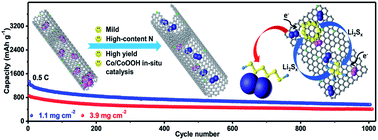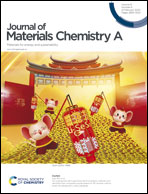High-yield and in situ fabrication of high-content nitrogen-doped graphene nanoribbons@Co/CoOOH as an integrated sulfur host towards Li–S batteries†
Abstract
Lithium–sulfur batteries (LSBs) are considered as one of the most promising electrochemical energy storage systems, thanks to their high energy density and low cost. However, it is still challenging to design appropriate sulfur hosts for advanced S cathodes in LSBs. Herein, we first devised an even milder and industrialized methodology for high-yield synthesis of high-content (∼3.8 at%) N-doped graphene nanoribbons (N-GNRs) in situ loaded with nano-dimensional metal compounds (Co or Co/CoOOH) by chemically unzipping N-doped carbon nanotubes using HNO3 or KOH for LSBs as advanced encapsulation matrices for sulfur. KOH/HNO3-involved unzipping mechanisms are reasonably put forward along with optimized unzipping parameters. Systematic physicochemical and electrochemical analyses reveal that the product obtained by using 10 M KOH as the unzipping agent, i.e., K-N-GNRs@Co/CoOOH, is the most efficient encapsulation host for high-performance sulfur cathodes in LSBs, benefiting from its appealing merits including high catalytic activity, superb electronic conductivity and exceptional physical/chemical adsorption. Encouragingly, the S/K-N-GNRs@Co/CoOOH cathode (∼73.7 wt% S loading) yields excellent long-duration cyclic performance and rate capabilities, even with high areal S loading (∼3.9 mg cm−2). More significantly, this work provides a smart integration of metal compounds with N-GNRs via a scalable synthetic strategy for next-generation LSBs as promising hosts.



 Please wait while we load your content...
Please wait while we load your content...